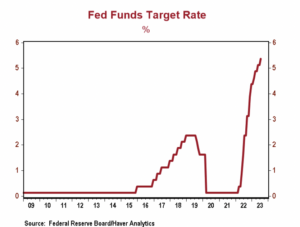Anyone hoping for excitement from the recent Fed statement was severely disappointed. As expected, the federal funds rate was lifted 25 basis points (bps) to a range of 5.25 to 5.50%. With the exception of the rate hike and slight wording changes – the “modest” pace of economic growth strengthened slightly to “moderate” – last week’s statement was a virtual carbon copy of the mid-June release.
It’s worth noting that, while the Fed did not release new economic forecasts, the economy has progressed largely in-line with what the Fed projected back in June. At that meeting, the Fed forecast it would be appropriate to raise rates two more times before year end. The first of those two hikes came Wednesday, and there is little reason to believe their view on the path forward has shifted.
During last week’s press conference, Chair Powell faced a barrage of questions trying to get a hint on the timing for the next rate move or guidance on when the job will be done, but Powell stuck firm to the Fed’s data dependent mantra. Powell said that between now and the Fed’s next meeting in September there will be two more employment reports, two more CPI reports, and a report on employment costs.
Markets will be watching them closely to figure out whether the Fed will raise rates again in September. If the Federal Reserve were paying close attention to the money supply, it would know that monetary policy is already tight. While M2 rose modestly in May and June following nine consecutive months of decline, the money supply has contracted 3.6% in the past year. Meanwhile, bank credit at commercial banks as well as their commercial and industrial loans are both down. If this isn’t tight, we’re not sure what tight means.
It remains to be seen how quickly the reductions in the money supply will translate into inflation getting back to the Fed’s 2.0% target, but the Fed has gained some traction against the inflation problem. And yet, once again, the Fed uttered not one peep about the money supply in its policy statement, nor did any journalist broach the topic.
It’s like the Fed has been operating in a fog without the appropriate tools to guide their way. Focus on supply chain disruptions, the level of the federal funds rate, consumer and business surveys, and inflation expectations had the Fed late to act and constantly adjusting course since. Having abandoned its long tradition of implementing monetary policy through scarce reserves and imposing a new policy based on abundant reserves following the financial crisis, they made their mistakes harder to correct. Whether they can cross the inflation finish line before the economy goes into recession will depend on how quickly the reductions in the money supply effects the economy later this year. They have their work cut out for them.
—
This was written by:
Brian S. Wesbury, Chief Economist, First Trust
Robert Stein, Deputy Chief Economist, First Trust
This report was prepared by First Trust Advisors L. P., and reflects the current opinion of the authors. It is based upon sources and data believed to be accurate and reliable. Opinions and forward looking statements expressed are subject to change without notice. This information does not constitute a solicitation or an offer to buy or sell any security.


